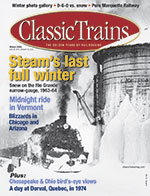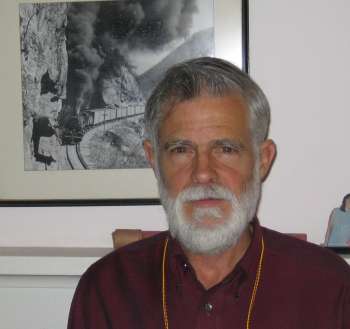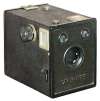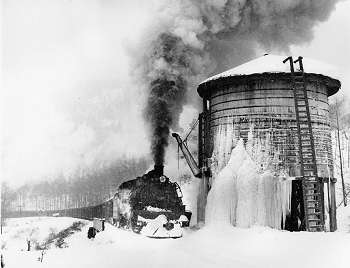- By Dan Veaner
- Around Town
 Print
Print  Frank Barry began photographing steam locomotives around 1946 when he was nine years old. Armed with an Ansco box camera, he took his first train pictures while visiting relatives in Hartford, CT. This began a love affair with steam engine photography that has lasted 60 years. "I had a kind of obsession," he says. "I took pictures of steam engines whenever I could." He still travels the world to photograph the last remaining active steam railroads. He has gone to 20 countries on four continents in pursuit of steam engines to photograph.
Frank Barry began photographing steam locomotives around 1946 when he was nine years old. Armed with an Ansco box camera, he took his first train pictures while visiting relatives in Hartford, CT. This began a love affair with steam engine photography that has lasted 60 years. "I had a kind of obsession," he says. "I took pictures of steam engines whenever I could." He still travels the world to photograph the last remaining active steam railroads. He has gone to 20 countries on four continents in pursuit of steam engines to photograph. This month his article on "Steam's Last Full Winter" is the cover story in Classic Trains magazine. It features his pictures of the D&RGW Narrow Guage railroad's last winter of steam operations in 1947. The magazine is on sale at Borders and Mr. Barry will be donating a copy to the Lansing Library, where it will be kept on display for a year. Additionally he will be speaking on "Extreme Steam" at the ScienceCenter December 13 at 7pm, showing slides of his photographs.
When he was ten years old his family moved to Rutland, Vermont, so his father could pursue a teaching job. "He had Saturday morning classes," Mr. Barry remembers, "so I went into Rutland with him and he dropped me off at the railroad station. I'd hang out at the station in the yards and the round house and take pictures." He became a sort of mascot. "The amazing thing about it in retrospect is, here was this ten year old kid in the roundhouse climbing up onto the engines, riding the turntable around and taking pictures. No one ever told me to leave. These guys knew me and they let me do this stuff."

Frank Barry
 Next the family moved to a house on the Delaware River. "It was the first and only time we moved any place where I could see the railroad from the house." The line went from Trenton to Phillipsburg with three freight trains and a passenger train that went up and back each day, all with steam engines. He began taking pictures of moving trains at this point, using his box camera that was manufactured in Binghamton
Next the family moved to a house on the Delaware River. "It was the first and only time we moved any place where I could see the railroad from the house." The line went from Trenton to Phillipsburg with three freight trains and a passenger train that went up and back each day, all with steam engines. He began taking pictures of moving trains at this point, using his box camera that was manufactured in Binghamton
He has been published in about 40 books and periodicals since 1958. During a college vacation he spent a day riding a narrow gauge railroad and taking pictures. Later he followed the train in a car to get action shots of the train. He was 21 when the pictures appeared in Trains magazine.
Over the years he got to know some of the railroad workers. "There were several instances in which I made friends. When we lived in New Jersey I became the mascot of the local freight crew. They let me ride their engine and even run it. Later when I got into college in Richmond, Indiana I got to know some railroaders there," he says. " When a vacation came along I would go someplace to take pictures of trains."
"One of my most amazing experiences was going to Canada where a couple of men let me ride in their engine for the entire run. I sent sent them pictures afterwards." He ended up meeting the men three times. Years later on a trip to Stratford he went to the station to ask after them. Mr. Barry contacted the one who still lived nearby, and brought a photo album to show him. He still had the pictures Mr. Barry had given him 30 years ago.
 During a 1964 Peace Corps assignment in New Mexico, Frank Barry photographed the Denver & Rio Grande Western Mikado as it steamed its way up the Cumberland Pass. |
He has also been active in helping to preserve passenger trains, helping to fight cuts in Amtrack. He is a past president of the Empire State Passengers Association, which lobbies for Amtrack. He is currently helping in an effort to restore passenger service to New York's Southern Tier.
For the past few years he and his wife Barbara have gone on trips so he could take pictures of steam engines. The last trip was to Inner Mongolia in China. "They built a new railroad. They started construction in 1990 as a bypass around Beijing. They finished it in 1995 and it was all steam. They had gotten UN money to build the line, but the grants didn't have any money for locomotives or cars. At that time the main Chinese railroad was dieselizing. So you could buy a steam engine very cheaply, and that's what they did."
This railroad ran steam engines for ten years. The Barrys went to China because they heard they were about to convert the railroad to diesel. "We got there just in the nick of time. This was big-time steam in scenic country. We had a great time and I got some beautiful shots." Next year they are planning a trip to Poland where steam engines are still used in places.
Lansing residents for 35 years, the Barrys' three children are all Lansing High School graduates. Retired from a career in community development, Mr. Barry worked at Cornell's Family Life Development Center for 28 years before retiring. He specialized in community organizing, creating workshops and services to deal with child abuse, then task forces to help communities create safer community environments.
But his passion is still steam trains. "I can't remember a time when I wasn't interested in trains," he says. "I want to do this while I can still remember what they are of, and while there are still people living who can remember steam locomotives.
----
v1i21



